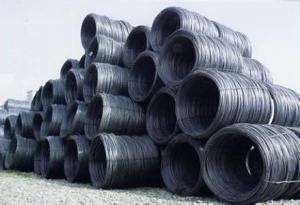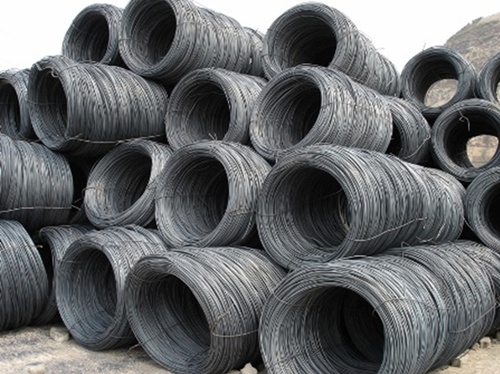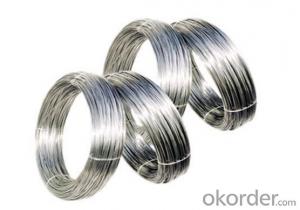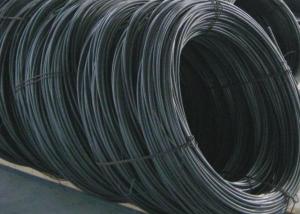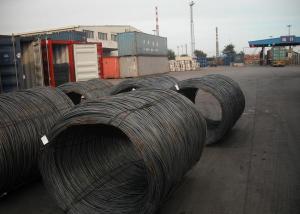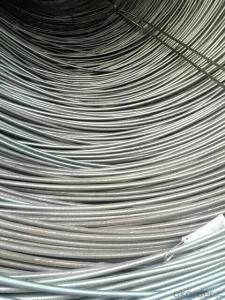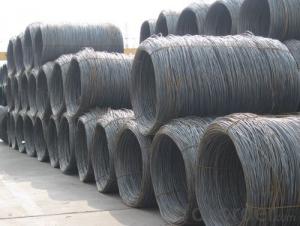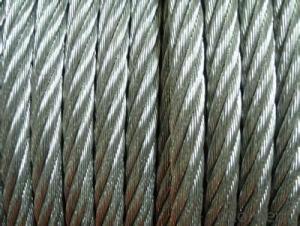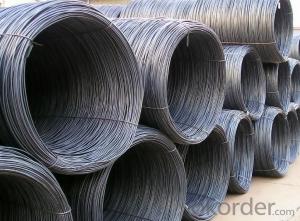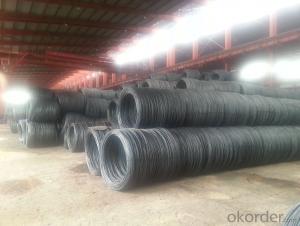Hot rolled wire rod
- Loading Port:
- China Main Port
- Payment Terms:
- TT OR LC
- Min Order Qty:
- -
- Supply Capability:
- -
OKorder Service Pledge
OKorder Financial Service
You Might Also Like
Also called wire rod, steel wire rod (s), small diameter steel usually refers to adisk. Wire diameters in the range 5-19 mm (usually 6-9 mm), the lower limit is the minimum size of hot rolled steel sections. The diameter of the round steelwire rod is relatively small, commodity form is rolled into plate supply, at the site of common have diameters of 6, 8, 10, 12 mm, low carbon steel are,generally not used for main reinforcement of reinforced concrete structure,much used for steel sleeve, and a small diameter for the brick reinforcedmasonry structure in the "". Many varieties of wire rod. Low carbon steel wire rod steel wire rod in the commonly known as cords, in high carbon steel wire,hard line. Blank wire rod are used mainly for drawing, but also can be directlyused as building materials and processed into mechanical parts. Stainless steel wire rod used in the manufacture of stainless steel wire, stainless steelspring wire, stainless steel wire and stainless steel wire rope forging steel wire.With the advances in production technology, has been the emergence of a square,
Hexagon, fan and other special-shaped section wire rod; the upper limit of the diameter has been expanded to 38 mm; disc weight from the original 40-60 kghas increased to 3000 kg. Due to the development of new heat treatment process after rolling, the iron oxide scale on wire rod surface obviouslythinning, organizational performance is greatly improved. Wire rod needs to use the bar straightening machine straightening feeding before use, but alsothe removal of oxides in the machine, but also in the bending tensilerepeatedly, a certain increase strength. Small site without straightening machine, windlass straightened wire rod used, if it is a direct pull is not desirable, easy to produce plastic deformation is too large, should end with ahammer to control the tension pulley.
Commonly used wire line production.
A, through the step by step the billet heating furnace heated to above 1100 degrees Celsius;
Two, heating the billet, after high pressure water descaling;
Three, into the roughing mill rolling, roughing mill for the strip plant;
Four, after roughing rolled piece into the water for cooling, in order to control its internal microstructure;
Five, leave water cooling period after entering the mill and finishing mill for further rolling;
Sixth, after finishing the shape of rolled piece formed by spinning machine spit out volume;
Seven, volume of wire forward cooled in the air cooling section;
Eight, at the end of the air cooling section, wire rod by coil unit into drum shape;
After nine, with drum shape of baling wire into the baling machine;
Ten, into the shipping department.
use
Wire is mainly used as the reinforcement of reinforced concrete and welding structure or reprocessed raw material (such as drawing, nail, etc.). According to the steel distribution directory, mild steel wire including ordinary hot-rolled wire rod, welding rod, blasting line with wire rod, conditioning threaded rod, high quality wire rod. USES a wide range of mild steel wire rod is mainly ordinary hot-rolled wire rod, also known as the common wire, it is composed of Q195, Q215, Q235 plain carbon steel hot rolling and nominal diameter 5.5 14.0 mm, rolling into each coil weight in 100-200 kg, now with no twist on the high speed wire mill rolling and control cooling after rolling, a diameter of 5.5 22.0 mm the grail weighing up to 2500 kg. Ordinary wire is mainly used for construction, wire drawing, packaging, welding rod and produce bolts, nuts, rivets, etc. High quality wire, only supply high quality carbon structural steel hot rolled wire rod. Such as ML08AL, 08 f, 10 b21, 35 mn, mn, 65, 75, 50 mn, etc. Used as the material of steel wire and other metal products and other structures, and other high-quality steel rolling of wire rod. More than 8 mm on high quality material, 8 mm below listed in metal products.
The dosage of wire rod is one of the large steel varieties. After rolling can be directly used in the reinforcement of reinforced concrete and the welding structure, and also can be used by the reprocessing. For example, by drawing into all kinds of wire, which are then rewinded into wire and twist wire rope, woven winding and heat treatment as a spring; The heat into the rivet and cold forging, cold forging and rolling as bolts, screws, etc.; Through cutting into heat treatment machine parts or tools.
Is the world's largest producer of wire rod in China, the annual output more than a third of total world production, wire is also China's second largest steel products, in the proportion of domestic steel production has been higher, 2007 domestic wire rod production accounts for 14.2% of the proportion of the total steel production in China. In recent years, domestic wire rod production base and the domestic crude steel production growth speed, almost remain at around 20%, growth slowed in 2007, down to 13.8%, the total is relatively nearly doubled in 2003. From import and export of wire rod, wire for a long time has been a main steel products export in our country, also is our country has maintained a net export status of steel varieties, especially the special rapid export growth in recent years. In 2007 China's exports of 6.238 million tons wire, year-on-year increase of 684000 tons, up 12.3%; Import 614000 tons, 91000 tons less than a year. From domestic consumption, wire wire application in the field of architecture is more, since 2000, driven by the domestic investment demand situation, domestic wire rod consumption has been maintained a fast growth.
Wire with deeper purpose: in many areas is one of the most widely in the IT industry.
Non-ferrous wire is widely used now.
- Q: How is steel wire rod used in the production of wire mesh conveyor belts?
- Steel wire rod is an essential component in the production of wire mesh conveyor belts. These belts are commonly used in industries such as food processing, mining, and automotive manufacturing. The steel wire rod is first processed through a series of machines to form wires of the desired thickness and strength. Once the wires are formed, they are woven together to create a mesh pattern. The steel wire rod provides the necessary strength and durability to withstand heavy loads and high temperatures typically encountered in conveyor belt applications. Additionally, the steel wire rod's flexibility allows the mesh to be easily bent and shaped to fit various conveyor belt configurations. The wire mesh conveyor belts offer several advantages over traditional conveyor belts made from other materials. The open mesh design allows for better airflow and drainage, making them ideal for applications that involve heat or liquids. They also provide excellent strength-to-weight ratio, ensuring long-lasting performance and reducing maintenance costs. Moreover, the steel wire rod used in wire mesh conveyor belts can be coated with materials such as PVC or galvanized to enhance its corrosion resistance. This further extends the lifespan of the conveyor belt, making it suitable for use in harsh environments or industries where corrosive substances are present. In summary, steel wire rod is a crucial component in the production of wire mesh conveyor belts. Its strength, durability, and flexibility make it ideal for withstanding heavy loads, high temperatures, and corrosive environments. These belts offer several advantages over traditional conveyor belts, making them a popular choice in various industries.
- Q: How is the surface finish of steel wire rod determined?
- The surface finish of steel wire rod is determined through a combination of manufacturing processes and quality control measures. First, the steel wire rod is produced through a hot rolling process, where the steel is heated and passed through a series of rollers to achieve the desired shape and thickness. During this rolling process, the surface of the steel wire rod can develop imperfections such as scale, which is a layer of oxide that forms on the surface due to the high temperatures involved. To remove this scale and improve the surface finish, the steel wire rod may undergo a descaling process, which involves methods like acid pickling or mechanical descaling. After descaling, the steel wire rod may undergo further processes like cold drawing or heat treatment to achieve the desired mechanical properties. These additional processes can also contribute to improving the surface finish of the steel wire rod. To ensure the desired surface finish is achieved, quality control measures are implemented throughout the manufacturing process. This includes regular inspections and testing of the steel wire rod to detect any surface defects or imperfections. Various techniques such as visual inspection, ultrasonic testing, and surface profilometry can be used to evaluate the surface finish and ensure it meets the required standards. In conclusion, the surface finish of steel wire rod is determined through a combination of manufacturing processes such as rolling, descaling, cold drawing, and heat treatment. Quality control measures are also implemented to inspect and test the surface finish, ensuring it meets the desired standards.
- Q: How is steel wire rod used in the manufacturing of wire for conveyor belts?
- The manufacturing of wire for conveyor belts relies heavily on steel wire rod. To begin the process, steel wire rod is produced through hot rolling. This involves heating steel billets to high temperatures and passing them through rolling mills to reduce diameters and increase lengths. Once the steel wire rod is ready, it undergoes further processing to become suitable wire for conveyor belts. This involves drawing the wire rod through dies that progressively decrease diameter and increase length. This drawing process improves the wire's strength, ductility, and surface finish. The wire obtained from the steel wire rod is then typically coated for added durability and resistance to corrosion. Coating methods can include galvanization or applying a polymer coating. After coating, the wire is woven or welded into the desired configuration to form the conveyor belt. Weaving the wire creates a flexible and sturdy belt that smoothly moves materials along the conveyor system. Alternatively, welding the wire creates a solid belt suitable for heavy-duty applications. In both cases, the strength and quality of the wire used for conveyor belts are crucial for reliable and long-lasting performance. Steel wire rod provides the necessary strength and structural integrity to withstand demanding conditions such as high tension, heavy loads, and continuous operation. Overall, steel wire rod plays a vital role in the manufacturing of wire for conveyor belts. It serves as the raw material, providing the required strength and durability for the efficient operation of conveyor systems in various industries.
- Q: How does the diameter of steel wire rod affect its strength?
- The diameter of a steel wire rod directly affects its strength. Generally, a larger diameter wire rod will have higher strength compared to a smaller diameter wire rod. This is because a larger diameter rod has a greater cross-sectional area, allowing it to withstand higher loads and stresses without breaking or deforming.
- Q: How is the steel wire rod market segmented?
- The steel wire rod market is segmented based on various factors such as product type, application, and geography. In terms of product type, the market can be segmented into low carbon steel wire rod, medium carbon steel wire rod, and high carbon steel wire rod. Each type of wire rod has different properties and is used for specific applications. Low carbon steel wire rod is commonly used in construction, automotive, and general manufacturing industries. Medium carbon steel wire rod is mainly used in the construction industry for reinforcing purposes. High carbon steel wire rod is primarily used in the production of wire for springs and ropes. Based on application, the steel wire rod market can be segmented into construction, automotive, energy, agriculture, and others. The construction industry is one of the major consumers of steel wire rod, as it is widely used for reinforcing concrete structures. In the automotive sector, steel wire rod is used for manufacturing various components such as springs, cables, and tire reinforcements. The energy industry also utilizes steel wire rod for power transmission lines. In the agriculture sector, steel wire rod is used for fencing and other applications. Geographically, the steel wire rod market can be segmented into North America, Europe, Asia Pacific, Latin America, and Middle East & Africa. Each region has its own demand for steel wire rod, driven by factors such as economic growth, infrastructure development, and industrialization. Asia Pacific is the largest market for steel wire rod, owing to the rapid growth in construction and automotive industries in countries like China and India. North America and Europe also have significant demand for steel wire rod due to their well-established construction and automotive sectors. Overall, the segmentation of the steel wire rod market provides a comprehensive understanding of the market dynamics, allowing companies to target specific segments and tailor their products and marketing strategies accordingly.
- Q: What are the standard lengths available for steel wire rod?
- The standard lengths available for steel wire rod typically range from 2,000 to 2,500 meters.
- Q: What are the factors that affect the cost of steel wire rod?
- There are several factors that can affect the cost of steel wire rod. 1. Raw material prices: The cost of steel wire rod is heavily influenced by the price of the raw materials used to produce it, such as iron ore and scrap metal. Any fluctuations in the prices of these raw materials can directly impact the cost of steel wire rod. 2. Production and manufacturing costs: The cost of producing steel wire rod includes various expenses, such as labor, energy, and equipment maintenance. Any changes in these production and manufacturing costs can affect the overall cost of the product. 3. Demand and supply dynamics: The demand for steel wire rod can influence its cost. If there is high demand and limited supply, the price of steel wire rod may increase. Conversely, if there is low demand and excess supply, the price may decrease. 4. Market competition: The level of competition among steel wire rod manufacturers can also impact its cost. Intense competition can lead to lower prices as companies strive to attract customers. On the other hand, a lack of competition may result in higher prices. 5. Transportation and logistics: The cost of transporting steel wire rod from manufacturers to end-users can contribute to its overall cost. Factors such as fuel prices, distance, and transportation infrastructure can affect these costs. 6. Government regulations and policies: Government regulations and policies, such as import duties, export restrictions, or environmental regulations, can impact the cost of steel wire rod. Compliance with these regulations may require additional investments, which can influence the product's price. 7. Exchange rates: Steel wire rod is often traded internationally, and exchange rate fluctuations can impact its cost in different countries. Changes in currency values can affect the import and export prices of steel wire rod, influencing its overall cost. Overall, the cost of steel wire rod is influenced by a combination of factors related to raw materials, production costs, demand and supply dynamics, market competition, transportation and logistics, government regulations, and exchange rates. Monitoring and understanding these factors can help businesses make informed decisions and strategies regarding the cost of steel wire rod.
- Q: What is the average carbon content in steel wire rod?
- The average carbon content in steel wire rod typically ranges between 0.06% and 0.08%.
- Q: How is steel wire rod used in the agriculture industry?
- Steel wire rods are commonly used in the agriculture industry for various purposes. They are primarily utilized in fencing systems to create sturdy and durable boundaries for livestock and crops. Additionally, steel wire rods are employed in constructing trellises and support structures for climbing plants, as well as in the fabrication of agricultural equipment such as harvesters and cultivators.
- Q: How is steel wire rod tested for resistance to hydrogen embrittlement?
- Steel wire rod is typically tested for resistance to hydrogen embrittlement using a variety of methods, including the slow strain rate test (SSRT) and the hydrogen permeation test. These tests involve subjecting the wire rod to controlled levels of hydrogen exposure and measuring the resulting mechanical properties and hydrogen absorption rates. Additionally, the wire rod can also undergo microscopic examination to identify any signs of hydrogen-induced cracking or embrittlement.
Send your message to us
Hot rolled wire rod
- Loading Port:
- China Main Port
- Payment Terms:
- TT OR LC
- Min Order Qty:
- -
- Supply Capability:
- -
OKorder Service Pledge
OKorder Financial Service
Similar products
Hot products
Hot Searches
Related keywords
